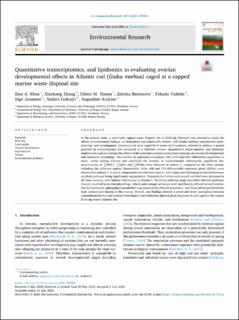| dc.contributor.author | Khan, Essa Ahsan | |
| dc.contributor.author | Zhang, Xiaokang | |
| dc.contributor.author | Hanna, Eileen Marie | |
| dc.contributor.author | Bartosova, Zdenka | |
| dc.contributor.author | Yadetie, Fekadu | |
| dc.contributor.author | Jonassen, Inge | |
| dc.contributor.author | Goksøyr, Anders | |
| dc.contributor.author | Arukwe, Augustine | |
| dc.date.accessioned | 2021-02-26T11:58:35Z | |
| dc.date.available | 2021-02-26T11:58:35Z | |
| dc.date.created | 2020-09-07T21:47:55Z | |
| dc.date.issued | 2020 | |
| dc.identifier.citation | Environmental Research. 2020, 189:109906 1-11. | en_US |
| dc.identifier.issn | 0013-9351 | |
| dc.identifier.uri | https://hdl.handle.net/11250/2730650 | |
| dc.description.abstract | In the present study, a previously capped waste disposal site at Kollevåg (Norway) was selected to study the effects of contaminant leakage on biomarkers associated with Atlantic cod (Gadus morhua) reproductive endocrinology and development. Immature cod were caged for 6 weeks at 3 locations, selected to achieve a spatial gradient of contamination, and compared to a reference station. Quantitative transcriptomic, and lipidomic analysis was used to evaluate the effects of the potential complex contaminant mixture on ovarian developmental and endocrine physiology. The number of expressed transcripts, with 0.75 log2-fold differential expression or more, varied among stations and paralleled the severity of contamination. Particularly, significant bioaccumulation of ∑PCB-7, ∑DDTs and ∑PBDEs were observed at station 1, compared to the other station, including the reference station. Respectively 1416, 698 and 719 differentially expressed genes (DEGs), were observed at stations 1, 2 and 3, compared to the reference station, with transcripts belonging to steroid hormone synthesis pathway being significantly upregulation. Transcription factors such as esr2 and ahr2 were increased at all three stations, with highest fold-change at Station 1. MetaCore pathway maps identified affected pathways that are involved in ovarian physiology, where some unique pathways were significantly affected at each station. For the lipidomics, sphingolipid metabolism was particularly affected at station 1, and these effects paralleled the high contaminant burden at this station. Overall, our findings showed a novel and direct association between contaminant burden and ovarian toxicological and endocrine physiological responses in cod caged at the capped Kollevåg waste disposal site. | en_US |
| dc.language.iso | eng | en_US |
| dc.publisher | Elsevier | en_US |
| dc.rights | Navngivelse 4.0 Internasjonal | * |
| dc.rights.uri | http://creativecommons.org/licenses/by/4.0/deed.no | * |
| dc.title | Quantitative transcriptomics, and lipidomics in evaluating ovarian developmental effects in Atlantic cod (Gadus morhua) caged at a capped marine waste disposal site | en_US |
| dc.type | Peer reviewed | en_US |
| dc.type | Journal article | en_US |
| dc.description.version | publishedVersion | en_US |
| dc.source.pagenumber | 1-11 | en_US |
| dc.source.volume | 189:109906 | en_US |
| dc.source.journal | Environmental Research | en_US |
| dc.identifier.doi | 10.1016/j.envres.2020.109906 | |
| dc.identifier.cristin | 1827932 | |
| dc.description.localcode | This is an open access article distributed under the terms of the Creative Commons CC-BY license, which permits unrestricted use, distribution, and reproduction in any medium, provided the original work is properly cited. | en_US |
| cristin.ispublished | true | |
| cristin.fulltext | original | |
| cristin.qualitycode | 2 | |

